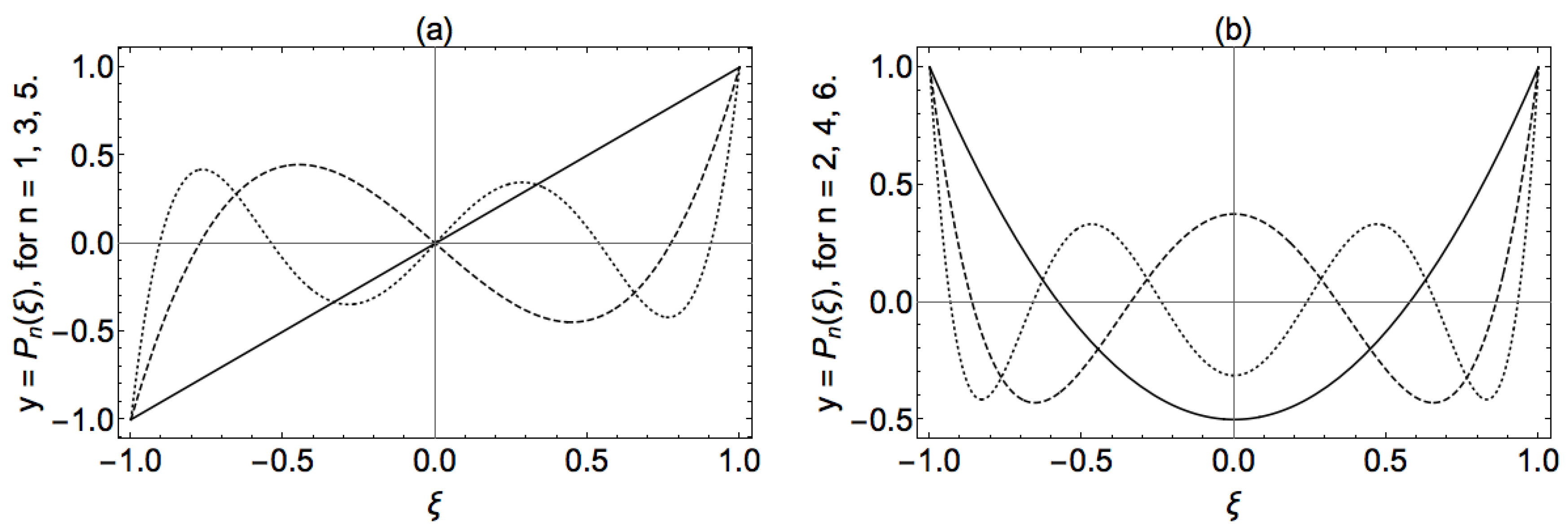The Singularity of Legendre Functions of the First Kind as a Consequence of the Symmetry of Legendre’s Equation
Abstract
:1. Introduction
1.1. Motivation
1.2. Singularities; Fuchsian and Legendre’s Equations
1.2.1. Singularities as a Selection Criterion in Physics
1.2.2. The Class of Fuchsian Differential Equations
1.2.3. Legendre’s Equation
1.3. Implications in the Natural Sciences
1.4. Frobenius’s Theory
1.5. Aim and Prospect
2. Form Invariance of an Equation and Implied Transformation Properties of Solutions
2.1. Transformation of Independent Variable
2.2. Form Invariance; Mirror Symmetry
2.3. Consequences of Symmetry of a Differential Equation for Its Solutions
3. Mirror Symmetric Fuchsian and Second Order ODEs with Regular Singular Points at =
3.1. General Result
3.2. Example: Implied Symmetry of Legendre Polynomials
3.3. Reverse Formulation: Absence of Symmetry Implies Unboundedness
4. Legendre Functions of the First Kind Are Neither Even nor Odd
4.1. Series Expansion about the Origin
4.2. Is Neither Odd nor Even When Is Non-Integer
4.3. Visualization and Summary
5. Conclusions
Funding
Data Availability Statement
Acknowledgments
Conflicts of Interest
References
- Whittaker, E.T.; Watson, G.N. A Course of Modern Analysis; Cambridge University Press: Cambridge, UK, 1935. [Google Scholar]
- Bateman, H. Higher Transcendental Functions; McGraw-Hill: New York, NY, USA, 1953. [Google Scholar]
- Morse, P.M.; Feshbach, H. Methods of Theoretical Physics; McGraw-Hill: New York, NY, USA, 1953. [Google Scholar]
- Abramowitz, M.; Stegun, I.A. Handbook of Mathematical Functions; Dover: New York, NY, USA, 1964. [Google Scholar]
- Hochstadt, H. The Functions of Mathematical Physics; Pure and Applied Mathematics; Wiley: New York, NY, USA, 1971. [Google Scholar]
- Fuchs, L.I. Zur Theorie der Linearen Differentialgleichungen mit veränderlichen Coefficienten. In Gesammelte Mathematische Werke von L. Fuchs; Fuchs, R., Schlesinger, L., Eds.; University Of Michigan Library: Berlin, Germany, 1865; Volume I, pp. 111–158. [Google Scholar]
- Fuchs, L.I. Zur Theorie der Linearen Differentialgleichungen mit veränderlichen Coefficienten. J. Die Reine Angew. Math. 1866, 66, 159–204. [Google Scholar]
- Gray, J. Linear Differential Equations and Group Theory from Riemann to Poincaré; Birkhäuser: Boston, MA, USA, 1986; ISBN 0-8176-3318-9. [Google Scholar]
- Frobenius, F.G. Reihen. In Gesammelte Abhandlungen; Serre, J.P., Ed.; Springer: Berlin, Germany, 1968; Volume 1, pp. 84–105. [Google Scholar]
- Boyce, W.E.; Di Prima, R.C. Elementary Differential Equations and Boundary Value Problems, 11th ed.; Wiley: Hoboken, NJ, USA, 2013; Chapter 5.6. [Google Scholar]
- Schiff, L.I. Quantum Mechanics; McGraw-Hill: New York, NY, USA, 1955. [Google Scholar]
- Rose, M. Elementary Theory of Angular Momentum; John Wiley & Sons: New York, NY, USA, 1957. [Google Scholar]
- van der Toorn, R. Elementary properties of Non-Linear Rossby-Haurwitz Planetary Waves Revisited in Terms of the Underlying Spherical Symmetry. AIMS Math. 2019, 4, 279–298. [Google Scholar] [CrossRef]
- Coddington, E.A. An Introduction to Ordinary Differential Equations; Prentice-Hall: Englewood Cliffs, NJ, USA, 1961. [Google Scholar]
- van der Toorn, R. Tandem Recurrence Relations for Coefficients of Logarithmic Frobenius Series Solutions about Regular Singular Points. Available online: https://www.preprints.org/manuscript/202202.0289/v1 (accessed on 23 February 2022).
- Jackson, J.D. Classical Electrodynamics; Willey: New York, NY, USA, 1962. [Google Scholar]
- Dong, H.; Zhang, D.; Guo, Y. A Reference Ball Based Iterative Algorithm for Imaging Acoustic Obstacle from Phaseless Far-Field Data. Inverse Probl. Imaging 2019, 13, 177–195. [Google Scholar] [CrossRef] [Green Version]
- Van der Toorn, R.; Zimmerman, J.T.F. On the Spherical Approximation of the Geopotential in Geophysical Fluid Dynamics and the Use of a Spherical Coordinate System. J. Geophys. Astrophys. Fluid Dyn. 2008, 102, 349–371. [Google Scholar] [CrossRef]
- Butkov, E. Mathematical Physics; Addison-Wesley Publishing Company: Boston, MA, USA, 1968. [Google Scholar]
- Wolfram Research Inc. Mathematica; Version 12.2; Wolfram Research Inc.: Champaign, IL, USA, 2020. [Google Scholar]
- Forsyth, A.R. A Treatise on Differential Equations; MacMillan: New York, NY, USA, 1903. [Google Scholar]
- Ince, E. Ordinary Differential Equations; Longmans, Green and Co. Ltd.: London, UK, 1927. [Google Scholar]
- Goode, S.; Annin, S. Differential Equations and Linear Algebra; Pearson: London, UK, 2014. [Google Scholar]


Publisher’s Note: MDPI stays neutral with regard to jurisdictional claims in published maps and institutional affiliations. |
© 2022 by the author. Licensee MDPI, Basel, Switzerland. This article is an open access article distributed under the terms and conditions of the Creative Commons Attribution (CC BY) license (https://creativecommons.org/licenses/by/4.0/).
Share and Cite
van der Toorn, R. The Singularity of Legendre Functions of the First Kind as a Consequence of the Symmetry of Legendre’s Equation. Symmetry 2022, 14, 741. https://doi.org/10.3390/sym14040741
van der Toorn R. The Singularity of Legendre Functions of the First Kind as a Consequence of the Symmetry of Legendre’s Equation. Symmetry. 2022; 14(4):741. https://doi.org/10.3390/sym14040741
Chicago/Turabian Stylevan der Toorn, Ramses. 2022. "The Singularity of Legendre Functions of the First Kind as a Consequence of the Symmetry of Legendre’s Equation" Symmetry 14, no. 4: 741. https://doi.org/10.3390/sym14040741
APA Stylevan der Toorn, R. (2022). The Singularity of Legendre Functions of the First Kind as a Consequence of the Symmetry of Legendre’s Equation. Symmetry, 14(4), 741. https://doi.org/10.3390/sym14040741






